
FOR the latest FNY Crosstown, I selected an uptown street in Yorkville/Upper East Side, an area I have neglected over the years and like many neighborhoods around town, a spot I should really see more often. And now that the Q train goes up there and has since January 1, 2017, I have fewer excuses not to, as the Q is just a block away from Penn Station (I find the 6 perennially overcrowded and uncomfortable). It appears now that the uptown Q is the only section of the planned Second Avenue Subway I’ll see in my lifetime, which now spans over 67 years. A new section running to Lexington Avenue and 125th hasn’t even begun construction yet; and construction typically takes 15-20 years. The downtown extension to Hanover Square at Pearl Street may happen by 2060 or so.
I found some interesting things to discuss on East 88th Street and walked east to west beginning at Carl Schurz Park. The name Carl Schurz pops up in two separate Manhattan parks miles apart. Carl Schurz Park, between East End Avenue, the FDR Drive and East 84th and 90th Streets, is named for a mid-19th century German immigrant (1829-1906) who became a US Senator from Missouri (1869-1875), Rutherford Hayes’ Secretary of the Interior (1877-81), editor of the New York Tribune and Harper’s Weekly. A statue of Schurz can be found at Morningside Drive and East 116th Street, and a lengthy avenue in Throgs Neck, Bronx, also commemorates him. Nearby Yorkville was heavily German in the past, and the park celebrates one of their own. His most famous quote was: “Our country right or wrong. When right, to be kept right; when wrong, to be put right.”
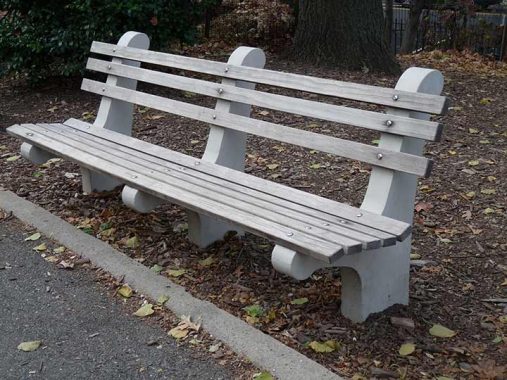
Interestingly, Schurz Park features newly built versions of the classic NYC concrete and wood park bench. Newer metal ones have been installed elsewhere, and the city has gotten away from wood because it tends to splinter after a few years and requires periodic upkeep. Metal benches are more “plug and play” and last longer.
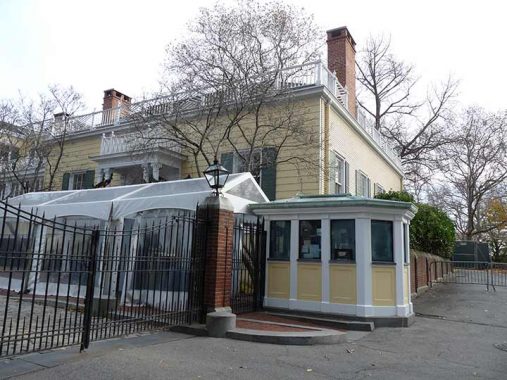
Unfortunately the best photo I can get of Gracie Mansion is at its (understandably) well-guarded front entrance in Scurz Park; better pictures can be had from boats on the East River. The mayoral residence Gracie Mansion at East End Avenue and East 89th Street, Gracie Square and nearby Gracie Terrace in Carl Schurz Park are all named for Scottish shipping entrepreneur Archibald Gracie (1755-1829) who purchased land at what was called Horn’s Hook after the Revolutionary War and built Gracie Mansion there in 1799. He received guests such as President John Quincy Adams and French monarch Louis Philippe. Gracie sold his estate in 1823 and it was acquired by New York City in 1891; its 11 acres were incorporated into Carl Schurz Park. Fiorello LaGuardia was the first NYC mayor to use it as a residence when he and his family moved in in 1942. Michael Bloomberg favored his nearby townhouse on East 79th Street during his 12 years as mayor.
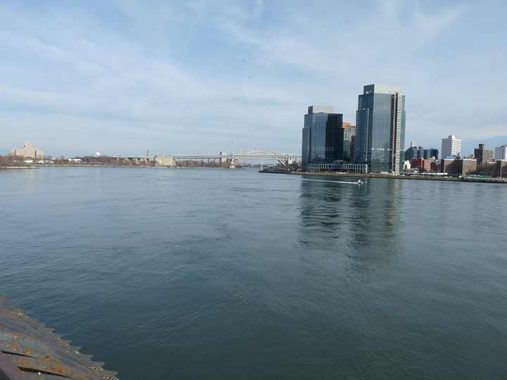
Carl Schurz Park’s John Finley Walk, named for Harper’s Weekly editor and City College president John Finley (1863-1940), runs along the East River and features views of Roosevelt Island and Queens. Looking northeast here, we see some new glassy high rises in Astoria as well as the Triboro and Hell Gate Bridges.
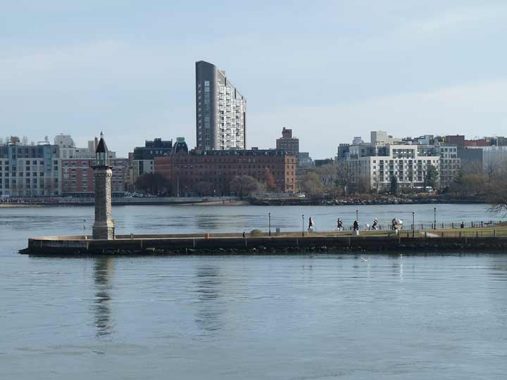
More new construction in Astoria behind two very old structures: the Roosevelt Island Renwick Lighthouse (1872) and the former Sohmer Piano Factory (1886).
I couldn’t begin my walk without mentioning the Henderson Place Historic District, East 86th Street, Henderson Place and East End Avenue. The alley, and parts of East 86th & 87th Streets and East End Avenue, are home to 24 row houses of the eclectic Queen Anne style built in 1883 by the firm of Lamb & Rich (who also built Sagamore Hill, Teddy Roosevelt’s Oyster Bay home) for developer John Henderson that are dwarfed by the high-rise apartment houses that are more typical of the area. Alfred Lunt and Lynn Fontanne, the famed husband-and-wife acting couple, lived on Henderson Place for years. The houses rented for just $650 in 1883!
Landmarking hasn’t prevented that solarium on the roof, though, I see.
Henderson Place was built as a development for persons “of modest means” but has become much more expensive in subsequent decades. In the mid-2000s, a Henderson Place house would cost in the seven figures. More photos and info on this page.
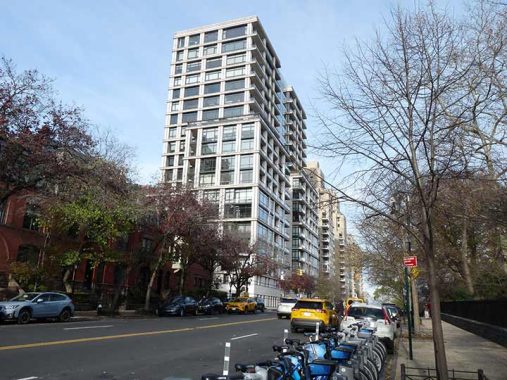
I do not oppose all new construction, just the imagination-free blue glass-clad towers. I do like the squarish-large window trend that has happened during the past decade, here on East End Avenue and East 87th.
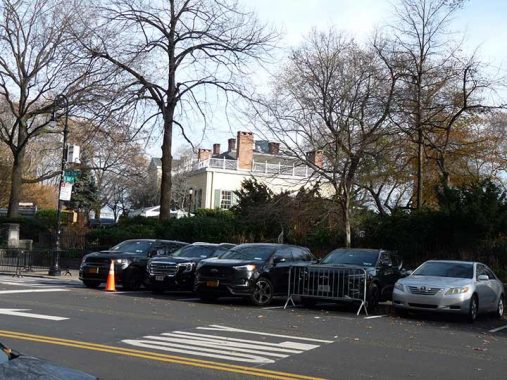
Another unfettered look at Gracie Mansion from East End Avenue, best had in fall and winter.
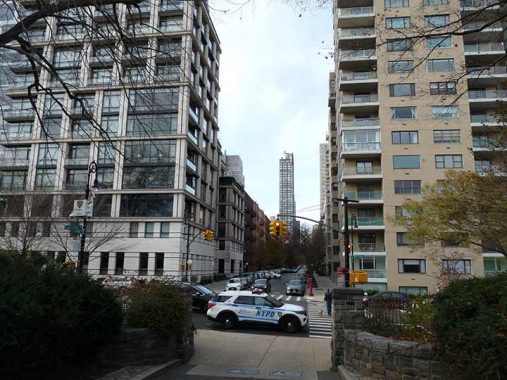
A look west up East 88th Street
At East End Avenue and East 88th, one of NYC’s oldest fire alarms. This design, with the sloped roof, was used in 1912-1913; later designs had the ice-cream-cone-shaped torch at the roofline. You can also tell the 1912-1913s by the interlocking “FDNY,” while later designs have four separate letters.
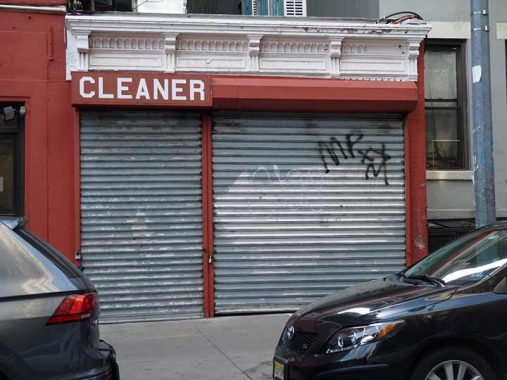
I was fascinated by 450A East 88th, a very small addition to the much bigger 450 at the corner of York Avenue. I always like signs that are succinct and direct, and this is a laundry that calls itself “cleaner.” I was here on Sunday, but the Google Street View shows it’s still in business. The tax photo from 1940 shows it was a tailor shop that year.
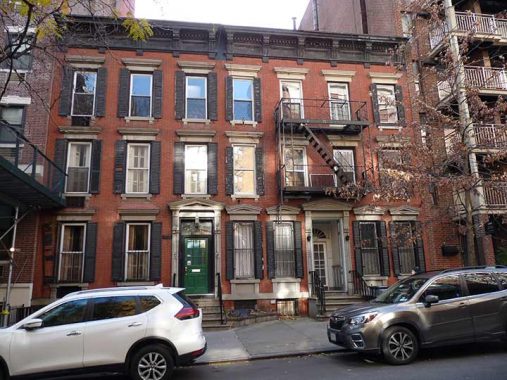
I was attracted to #436 and 438 East 88th because they looked older than other buildings on the block, because of their extra ornamentation. According to the AIA Guide to NYC they were built in the 1860s and are “brick and limestone townhouses from a gentler streetscape.” Why does 438 have a fire escape, but not 436?
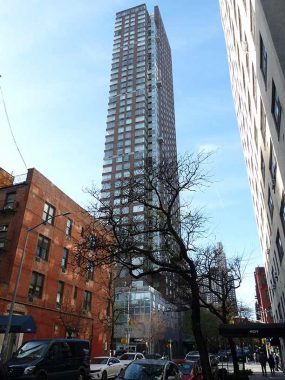
Though I’m not necessarily in favor of “supertall” buildings, they nonetheless attract my camera. #360 East 88th, Leighton House, is a 46-story condominium tower west of 1st Avenue built in 1990, years before the term “supertall” was coined. The Upper East Side has a number of these incongruously tall buildings, as do the 50s streets south of Central Park and also at Madison Square.
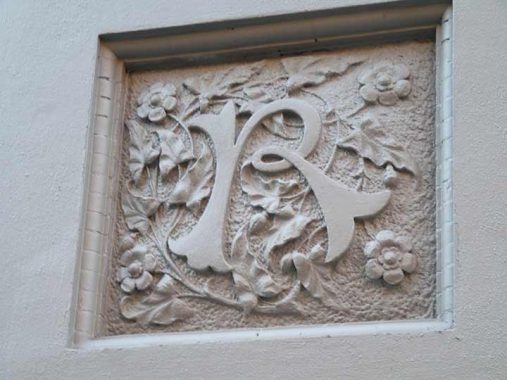
I took one look at the building next door, #350 East 88th, and knew it was an older building that had been “updated”. You can get a pretty good look at what the Rhinelander Children’s Center, built in 1891 as a “school for crippled children,” or so it says on my map, on the 1940 tax photo. It was “modernized” with a stucco coat in 1958, and so it has looked like this nearly as long as it originally appeared. The remake did spare the fanciful “R” for Rhinelander exterior initial, which will be explained below.
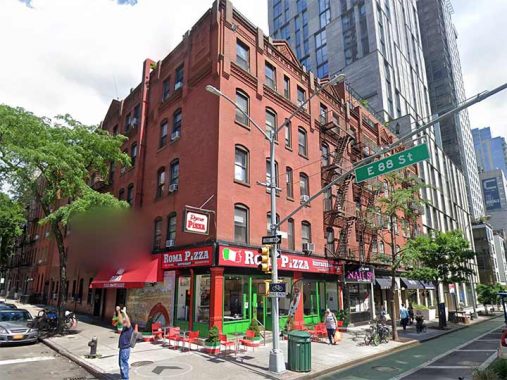
I was totally fascinated with the intricate terra cotta work at #339 East 88th and the corner building on 1st Avenue, #355 East 88th. The buildings are not landmarked and my usual sources are silent on these buildings, but my guess is they were developed at the same time by the same architect in the late 1800s. The corner shot is from Street View and so has its occasional maddening blurriness in spots.
I was also fascinated with #329 East 88th further west because I noticed it once had a storefront. If we look at its 1940 tax photo we see that this block of East 88th once had multiple storefronts apparently seeking traffic from congregants at the massive Church of the Holy Trinity (see below). #329 was once a grocery.
Church of the Holy Trinity
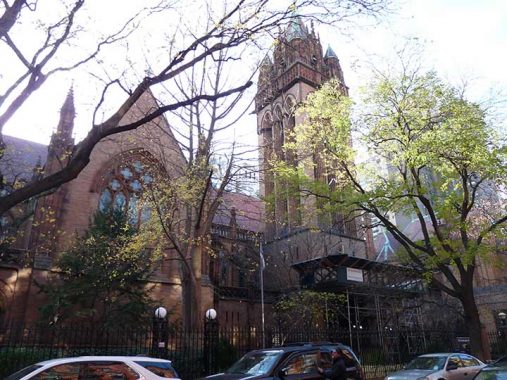
In a part of town I explore sparingly it’s fun to find massive edifices with long histories of which I was previously unaware, such as the massive, French Gothic Church of the Holy Trinity, #136-332 East 88th, designed by Barney & Chapman and built as a complex with its parish house from 1896-1899. It’s so good, I obtained multiple images, but it’s hard to get a complete exterior photo since it is set back from the street and fronted by street trees. The plaque gives a succinct history: but the plot was previously in the Rhinelander family since 1798, hence that date on the cornerstone. Serena Rhinelander donated the land in honor of her father and grandfather, with the congregation moving from its original location here in 1899.
The church is Episcopalian (Anglican). I’ve said often that most consistently gorgeous church buildings are created by the Episcopalians and Roman Catholics, though there are other great houses of worship in other Judeo-Christian and Muslim denominations. Read its detailed history on this page.
The stretch of East 88th does have some active storefronts, including a basement shop, JFD Shoe Repair, at #223. The sign is in the Souvenir Bold font.
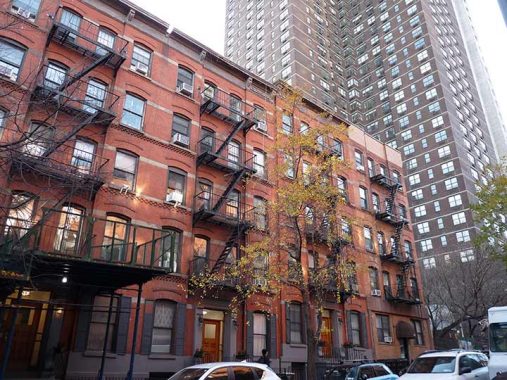
I’m all about contrasts in Forgotten NY. These four brick walkups, #208-214 East 88th, are the only older buildings on the south side of East 88th between 2nd and 3rd Avenues. In the rear is the high rise #1555 3rd Avenue, whose residents are graced with a Whole Foods on the ground floor, parking in the basement, and a Barnes and Noble across the street.
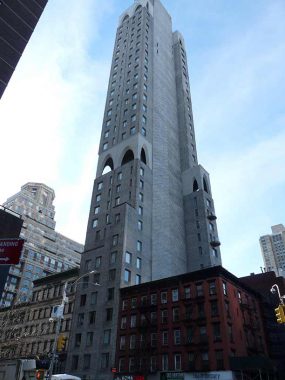
Towers beget towers: Here’s #180 East 88th, which actually faces 3rd Avenue where #1558 would be. How did this unusual situation come about?
In 2014, a developer sought approval for an odd alteration to a lot on the Upper East Side of Manhattan. Instead of a 30-foot-deep lot, abutting East 88th Street, the developer sliced off a narrow sliver only four feet wide, reports the New York Times.
The change, approved by New York City, became part of the official map of taxable lots that November. But the motivation behind it became clearer only in recent months.
That thin buffer between the tower building’s lot and the street allowed the developers, DDG Partners, to avoid an array of requirements for a structure’s shape and size when it touches the street — and ultimately, opponents of the project say, build a tower about 60 feet higher. The Upper East Side tower takes its address from 88th Street, but because of the tiny lot, the entrance is around the corner on Third Avenue. e-architect
Though Protestantism originated with Martin Luther in the Holy Roman Empire in what later became Germany in the 16th Century, a substantial Roman Catholic population remains in Germany and with German immigrants to the USA.
Kolping House was built as part of an international network of Catholic Worker’s Clubs, offering skilled journeymen temporary housing.The Society was founded in Germany by Adolph Kolping in the 1840s and a New York branch was established in 1888. This vaguely medieval building was financed by the Society of Catholic Mechanics and designed by Karl Otto (of the architectural firm Daus & Otto) in 1913-14. Comparable to a YMCA, it was described as “an honest effort to contribute its share towards improving the lot of the working class by offering laborers a comfortable home, good board at a reasonable price, wholesome entertainment, and also instruction and inspiration for self-education.” Kolping House [#165 East 88th between Lexington and 3rd Avenues] continues to offer inexpensive lodgings to students, interns, and other short-term visitors to New York City. [Friends UES]
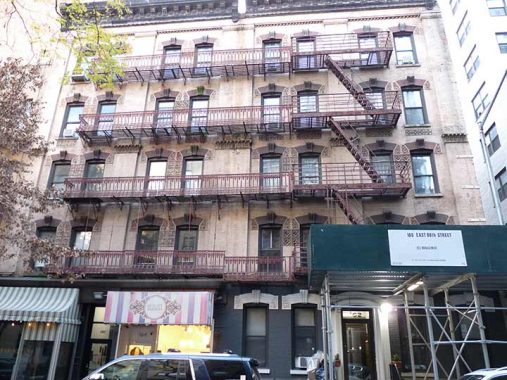
The wrought iron balconies at #162-164 East 88th are reminiscent of the larger ones in New Orleans’ French Quarter.
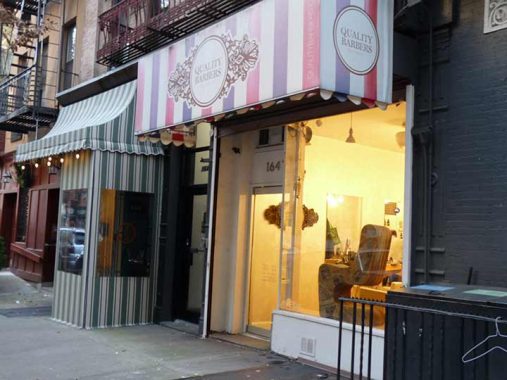
A pair of colorful storefronts east of Lexington, for Bar Vivant and Quality Barbers.
Philip House, #141 East 88th at Lexington, a luxury apartment building constructed in 1927, was converted to condos in 2013. The building’s website has some photos of the sumptuous interiors.
Immanuel Evangelical Lutheran Church (1886) at East 88th and Lexington is another reminder of the former Germanic nature of Yorkville. Unlike many churches around town, its website has a detailed history and architectural highlights. As the cornerstone states, the congregation was founded in 1863.
The German inscription means:
Christ the Cornerstone, Christians the Bluestone building block, God bless the building!
and apparently comes from St. Paul’s epistle to the Ephesians. Ephesus was a city in what is now western Turkey.
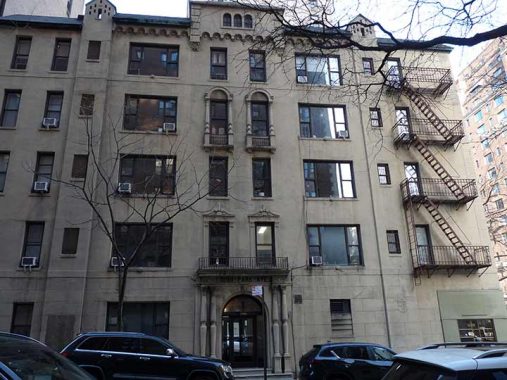
#1082 Park Avenue at East 88th is described in the AIA Guide as “Sicily in terra cotta.” It’s another apartment building from 1927, which was apparently a good year.
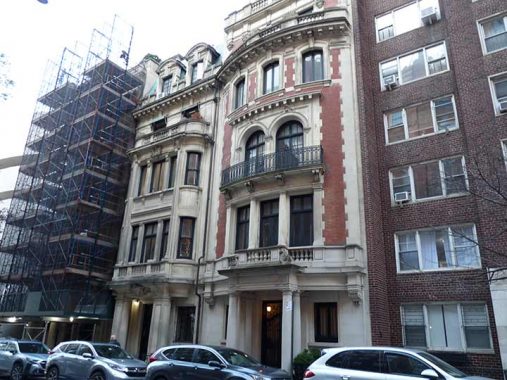
The joyously Beaux Arts #7 East 88th Street, partially covered by scaffolding, was built in 1902 as three separate residences. In 1905, #7 was purchased by distinguished attorney James C. Carter, who promptly fell ill and died 9 months after moving in at age 77. It was then purchased by Edward Charles Schaefer, president of the Germania Bank (a graffiti-scarred former Germania Bank branch at the Bowery and Bleecker street was the home of famed photographer Albert Maysles and his family for years).
Next door, on 5th Avenue, is the decidedly postmodern Solomon R. Guggenheim Museum, 5th Avenue and East 88th Street, but that’s a matter of preference. The spiral-shaped building is the only major building in Manhattan designed by Frank Lloyd Wright. Wright’s other building in the five boroughs is Crimson Beech, a ranch house on Lighthouse Hill in Staten Island. Both buildings were completed in 1959 and Wright did not live to see the completion of either.
“The Goog” is so well-known and not “Forgotten,” so I won’t dwell on it here; but Wright has always been my favorite architect. More than a decade ago I visited the museum but made a mistake, seeing the exhibits from the bottom floor to the top. That’s all on an uphill ramp and by the time I got to the top floor my legs were tired indeed!
Check out the ForgottenBook, take a look at the gift shop. As always, “comment…as you see fit.” I earn a small payment when you click on any ad on the site.
4/5/25

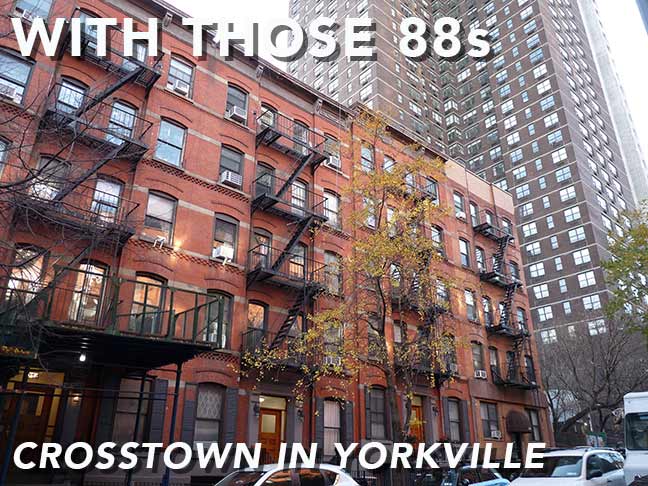
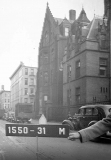
17 comments
“…the Triboro and Hell Gate Bridges.”
It’s a pleasure to see that Triboro is not Forgotten.
Meanwhile, not too far away, history is repeating itself:
https://nypost.com/2025/04/06/opinion/save-our-buildings-or-the-bronx-and-the-rest-of-ny-will-burn-again/
The middle line on the Lutheran church cornerstone means “Christians the building block”.
There used to be a fireboat station next to Gracie Mansion in the 1960s
A number of years after the fireboat station was decommissioned, it spent a good stretch as a small environmental education center (perhaps affiliated with the Asphalt Green recreation area between East End and York Aves.?), and much more recently has been reconsructed as a ferry landing/terminal.
Yankees legend, Lou Gehrig grew up in Yorkville.
The tall building on East End Avenue between East 87th and east 88th St was converted from the former Doctors Hospital a few years ago.
The old Doctors Hospital was demolished around 2005. The current apartment building was newly constructed on the lot several years later. The new building was not a conversion of the hospital building.
The Schurz quote reminds me somehow of G.K. Chesterton, who allowed as how “My country, right or wrong” always sounded to him like “My mother, drunk or sober”
Google Maps shows the name of the cleaners to be Chu’s Laundry.
Given the basic implosion of the Episcopal Church in recent years I wonder how long Holy Trinity will be able to remain open. Upkeep on the structure must be expensive.
Back in the 1960’s and early ’70’s Walt Kelly, the creator of “Pogo”, lived in a townhouse on East 89th Street.
He used to hang out at the bar in a place located at 200 East End Avenue. I believe it was called the “Oriental Room”.
Back in the days when NYC phones had alpha-numeric exchange names, and 212 covered all 5 boroughs, the Yorkville area had a RHinelander 4 phone exchange. Interestingly, MS word shows “RHinelander” as a typo because it mixes upper and lower case. If that phone exchange still exists it would be 212-744-xxxx.
I answered my own question a few minutes later when I looked up dry cleaners in Yorkville, the type of small business which would have an old style 212 phone number. Sure enough I found a dry cleaner on E 80th Street with the phone 212-744-xxxx (last four digits not identified for privacy sake). You’ve got to be at least 65 to remember alpha-numeric phone numbers with named exchanges.
We lived on 85th st. near York ave. and our phone number was
TRafalgar.That was phased out in the 70s
My parents lived on East End/88th for many years, & I’ve lived at Park/87th even longer.
So this is my neighborhood, and thanks for covering it so well. And BTW, I have your book.
There’s a Rhinedlander Ave in the Bronx also
“Yorkie” having the “RHinelander” exchange would make sense given the ancestry of some of those in the neighborhood, even if only by coincidence. OTOH, my aunt and uncle, who lived in Astoria by the time I was old enough to understand such things, had “LH5” as the exchange, which they always spoke of as “Lenox Hill”, seemingly a disconnect. (No pun intended…)
Many years ago, I rented an apt. at E. 90th and 2nd Ave. Being a short person, I had great difficulty accessing the upper kitchen cabinets, which seemed to me unusually high up. The realtor explained that it was because many places in Yorkville used to be inhabited by people from Northern Europe/Scandinavia, who were tall…